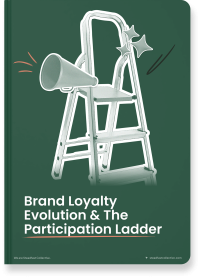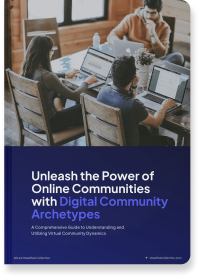Imagine buying planet-friendly products from reputable companies with excellent service from happy employees. Companies like Patagonia embody this vision, prioritising community and sustainability (Dean, 2024). Ardent fans and goodwill follow.
To benefit from a community-centric approach, a well-aligned company culture is vital. It is foundational, like the roots of a tree. Consistency is key; discrepancies between values and actions are quickly noticed. Keep your community onside, and your business will flourish.
Creating exceptional cultures that foster innovation and loyalty requires deliberate effort. Read on to understand company culture, its significance, and how to implement effective strategies. Learn how to spark a cultural revolution that benefits your organisation, your people, and the wider community.
Redefining culture
Your organisational culture shapes your company reputation and performance, serving as the conduit for your organisation's strategy delivery. It influences how all stakeholders perceive your brand (Hastwell, 2023).
Often dubbed "the way things are done around here" (McHale, S. 2020), it encompasses values, beliefs, systems, and rules guiding employee behaviour, resulting in consistent observable patterns within organisations (Watkins, 2013).
Like clay, culture is malleable and can be reshaped. Astute leaders cultivate and incentivise behaviours aligned with desired outcomes, recognising every employee's role in sustaining company culture. They understand that weak cultures undermine strategy (Guley and Reznik, 2019) and that cultures can be tailored to achieve specific aims.
Why culture matters
The correlation between culture and success is well established. Numerous studies confirm the link between a positive culture and enhanced performance. A Duke University survey of over 1,800 CEOs and CFOs worldwide, revealed a robust corporate culture fosters improved delivery, cost reductions, higher productivity, and enhanced creativity. A staggering 92% of respondents believe a positive culture adds organisational value (Duke Fuqua School of Business, 2015).
Organisations with healthy cultures, not only demonstrate a 60% higher return to shareholders, but also greater resilience during transformational change. Companies with a long-term focus have the healthiest cultures (Duan, Krishnan, Weddle, 2017).
Duke's research validates this finding providing evidence that effective cultures are less likely to be associated with short-termism, unethical behaviour or earnings management to pad quarterly earnings," (Duke Fuqua School of Business, 2015). Unlike products, company culture is inherently unique and cannot be replicated (McHale, 2020). Nurturing it pays dividends. It is one of the most effective ways to outperform competitors and protect company and community interests.

Signs of a healthy company culture
Companies that care about their people, care about their culture. In addition to strategic alignment, healthy cultures foster trust, collaboration and advocacy.
They promote diversity and inclusion, accountability, learning and innovation while making work meaningful to employees (Duan, Krishnan, Weddle, 2017). Actions are congruent with values.
People feel empowered and appreciated. They can make a difference at any level. Admitting mistakes is not seen as failure, but rather an opportunity to innovate, test and learn.
The pitfalls of a poor culture
Toxic cultures have damaged numerous businesses, resulting in significant repercussions. Recent examples include:
Allegations of unethical behaviour and harassment at Uber led to the CEO's resignation.
Brewdog commissioned an independent review after claims of a ‘culture of fear’ tarnished their reputation (Witts,, 2021).
The Post Office Horizon Software Scandal highlighted in an ITV drama severely damaged Fugitsu's brand health after its airing (Shakespeare, 2024).
Social platform X’s popularity is jittering due to cultural concerns associated with its new owner.
Unhealthy cultures frequently result in failed transformation projects (74% as reported by McKinsey, 2015) and trillions in lost productivity due to employee disengagement (Pendell, 2023).
While repairing cultures is notoriously difficult, regeneration is possible. Eliminating toxicity and cultivating a healthy culture is worth the effort as it will yield a competitive edge.
The Culture Nexus — putting people at the heart of your business
IMAGE HERE
Our Community-first Culture Nexus highlights the essential features of a healthy culture so you can create one. It also provides the framework for our Digital Community Leaders Survey that benchmarks your progress against industry norms.
The growth rings that shape customer experience
At its centre is Community or Customer Experience (CX), reinforced by the growth rings that make up the Culture Nexus.
They include:
Strategy
Technology and operations
Capabilities
Mindsets, values and behaviours
These indissociable components work in tandem to deliver your entire community or ecosystem experience, the culmination of all stakeholder engagements across all touchpoints.
The aim of your company culture is to deliver the best possible community experience for your customers, employees and partners. Maximise it by systematically strengthening all growth rings.
Your strategy sets the direction, but leave room to pivot
Strategy, the first growth ring, sets time-bound aims, ideally allowing for flexibility regarding how to achieve them. Involve people in strategic planning. Define the direction with your mission, then collectively develop a shared vision and roadmap everyone supports.
Help individuals see how their role contributes to the strategy and what mindsets and behaviours will help them succeed. Inclusive planning, drawing on customer, community, and market insights, strengthens strategy and improves its chances of success through collective buy-in.
Balance long and short-term needs. A longer-term focus not only contributes to a healthy culture, it attracts generations who value purposeful work (Kelly, 2021).
Be the heart of your ecosystem
Maintaining trust, a positive reputation, and fostering collaboration internally and externally are crucial in an interconnected society and marketplace. Companies with strong networks of customers, partners, investors, and talent thrive. The ecosystem economy emphasises impact and adaptive cultures (Jacobides, 2019).
A healthy organisational culture encourages adaptive mindsets and behaviours, essential in today's volatile business landscape. The recent pandemic highlights the importance of adaptability.
Responding to external signals is vital for success. Seek feedback from key stakeholders and follow proven community-building guidelines (link to our articles) as you progress your strategy.

Resilient operations unlock value
Operational discipline and procedures that reinforce connected cultural values are the second growth ring in the Culture Nexus. To collaborate with others requires new ways of working, antithetical to the top down command and control methods often associated with cultures of fear. Agile approaches, design and systems thinking, and community engagement, all help people collaborate and work towards common goals.
Empowering frontline teams to leverage customer insights to improve experience leads to greater employee and customer satisfaction. The most customer centric companies devolve power giving employees discretion to solve customer problems at pace. They also make time for risk taking, reflection, and learning.
Psychological safety seals the deal
Genuine collaboration across silos and company borders requires psychological safety. It is a shared belief that interpersonal risk-taking can occur without fear of repercussions (Gallo, 2023).
A safe climate encourages open expression, risk-taking, admitting mistakes, and offering feedback without punishment or humiliation. Psychological safety fosters innovation, better health outcomes, and improved performance. It is vital for building high-performing teams and resilient organisations (Edmonston, 2018).
When employees feel valued, they are more inclined to exceed expectations to delight customers and stakeholder communities. Psychological safety prevents mere compliance and encourages genuine effort.
Leverage data and technology
Customer-centric operations at scale are made possible by technology. Can you access and act on the customer data you need to make informed business decisions? If not, like many organisations, you have important work to do.
Technology has the potential to help you operate more efficiently. However, it will only deliver value if the right conditions exist for people to use it.
Put digital transformation plans in place to reap the benefits of digital, data, and technology. Ensure they improve your community experience with cultural alignment. Link to Steadfast article on community software.
Diverse capabilities drive impact
The next growth ring is capabilities. Hire for customer obsessed mindsets as well as specialist skills. Seek resilient, positive people with curiosity and a commitment to lifelong learning. Hire from diverse backgrounds to maximise creativity and become a vehicle for innovation and social mobility.
Appoint leaders who establish a trusting environment and are effective communicators. Recruit ambassadors who model the behaviours you want to scale across your organisation and beyond. Involve empathetic community managers in nurturing your community-first culture.

Bring on the polymaths
As digital and cultural transformation requires the introduction of new skills and ways of working, the more varied and versatile the skillsets, the more valuable the employee.
Attracting people with broad and deep skills into your organisation is beneficial as they may be more adaptable as company offers and operations evolve (di Bartolomeo, 2020). Life long learners relish new challenges.
Incentivise desired behaviours
We explored the importance of incentives in our Community Participation Ladder recognising the role they play in inspiring desired behaviour.
Incentives are just as relevant for culture design. To reinforce desired behaviours, reward them. Pay is not enough on its own. Recognition and praise reinforce achievements aligned with strategy and culture.
Elevate your ambassadors to inspire others to follow their lead. Champion the ones who demonstrate your values through their daily acts. Empower them to ignite a cultural revolution.
Is your culture fit for purpose?
The final growth ring is culture; it is the ultimate enabler of your community experience. Is your culture your superpower or will it undermine your strategy?
Brands that recognise the need to consistently uphold the provision of high quality products and services that bolster their brand reputation care deeply about culture and appreciate its worth. They respect the intrinsic value of its halo effect.
Company culture may be assessed in many ways. From satisfaction surveys to behavioural audits like the Market Responsiveness Index (MRI), the aim is to understand whether you are living up to your values so you can close the perception gap that typically exists (Brown and Brown, 2014).
Depending on the outcome of your research, you may need to undertake a culture change programme aligned with your overarching business goals. Crucially, consider how embracing a customer and community centric culture will impact business priorities as you make the culture shift.
Strong cultures generate value for individuals, organisations, and society at large. Use the growth rings of the Culture Nexus to ensure your community experience is outstanding and your company flourishes.
By Ann Longley
References
Brown, C., Brown L., The Customer Culture Imperative: A Leader’s Guide to Driving Superior Performance, McGraw Hill Education New York, 2014.
Carter, Dean, Inside Patagonia’s Corporate Culture That Prioritizes Flexibility and Work-Life Balance, Future of Business and Technology, Available at:
https://www.futureofbusinessandtech.com/employee-wellbeing/inside-patagonias-corporate-culture-that-prioritizes-flexibility-and-work-life-balance/. Accessed 8 Feb 2024.
di Bartolomeo, M., What employee type or shape are you?, Axelos, August 13, 2020, Available at: https://www.axelos.com/resource-hub/blog/what-employee-type-or-shape-are-you, Accessed 12 February 2024.
Duan,.I, Krishnan, R., Weddle, B., The yin and yang of organizational health, McKinsey Quartlerly, Nov 2017, Accessbile at: https://www.mckinsey.com/capabilities/people-and-organizational-performance/our-insights/the-yin-and-yang-of-organizational-health, Accessed 12 Febrary 2024.
Duke Fuqua School of Business, How Corporate Culture Affects the Bottom Line, 12 Nov 2015, Available at: https://www.fuqua.duke.edu/duke-fuqua-insights/corporate-culture, Accessed 12 February 2024.
Edmondston, Amy, The Fearless Organization, Creating Psychological Safety in the Workplace for Learning, Innovation, and Growth, Wiley, 2018.
Gallo A., What Is Psychological Safety? Harvard Business Review, February 15, 2023, Available online at https://hbr.org/2023/02/what-is-psychological-safety, Accessed 12 February 2024.
Guley, G. and Reznik, T., Culture eats Strategy for Breakfast and Transformation for Lunch, Jabian Journal, 2019, Available at https://journal.jabian.com/wp-content/uploads/2019/10/701_JJ_Fall_19_Culture_Eats_Strategy.pdf, Accessed 31 January 2024.
Hastwell, Claire, Elements of a Great Company Culture, 8 June 2023, Available at:
https://www.greatplacetowork.com/resources/blog/elements-of-great-company-culture, Accessed 12 February 2024.
Kelly, C., ‘Post-truth’ climate impacts Gen Z’s conflicting brand perceptions, Forrester says, 20 Jan 2021, Available at:
https://www.marketingdive.com/news/post-truth-climate-impacts-gen-zs-conflicting-brand-perceptions-forrest/593640/, Accessed 12 February 2024.
McHale, Siobhan, The Insider's Guide to Culture Change: Creating a Workplace That Delivers, Grows, and Adapts, Harper Collins Leadership, 2020.
Jacobides, Michael G., In the Ecosystem Economy, What’s Your Strategy? The five questions you need to answer, Harvard Business Review, September–October 2019, Available at: https://hbr.org/2019/09/in-the-ecosystem-economy-whats-your-strategy, Accessed 30 January 2024.
McKinsey & Company, How to beat the transformation odds, 2015, Available at:
How to beat the transformation odds - McKinsey, Accessed on 12 February 2024.
Pendell, R., 11 September, 2023, Employee Engagement Strategies: Fixing the World's $8.8 Trillion Problem, Available at: https://www.gallup.com/workplace/393497/world-trillion-workplace-problem.aspx, Accessed 12 February 2024.
Shakespeare, S., Fujitsu brand health plummets following the broadcast of Mr. Bates vs. The Post Office, 31 January 2024, Available at: https://business.yougov.com/content/48501-fujitsu-brand-health-plummets-following-the-broadcast-of-mr-bates-vs-the-post-office, Accessed 12 February 2024.
Watkins, M. D., What is organisational culture? And why should we care, Harvard Business Review, May 2013.
Witts, S., BrewDog sets out plans for culture review after 'toxic' workplace claims, The Caterer, 14 July 2021, Available at: https://www.thecaterer.com/news/brewdog-staff-culture-review-misconduct-allegations, Accessed 12 February 2024.


